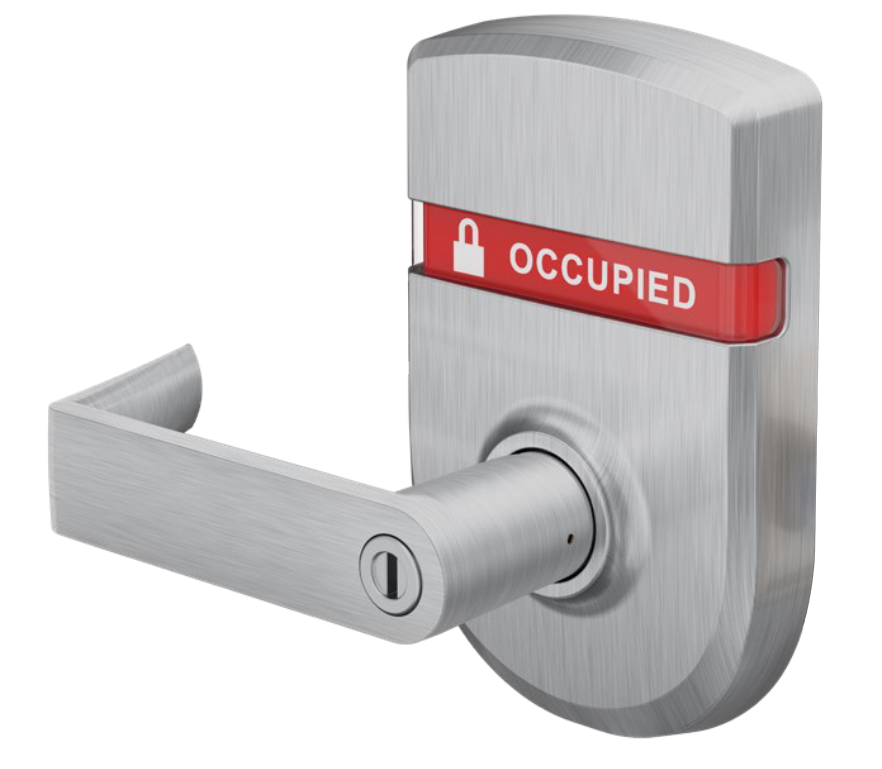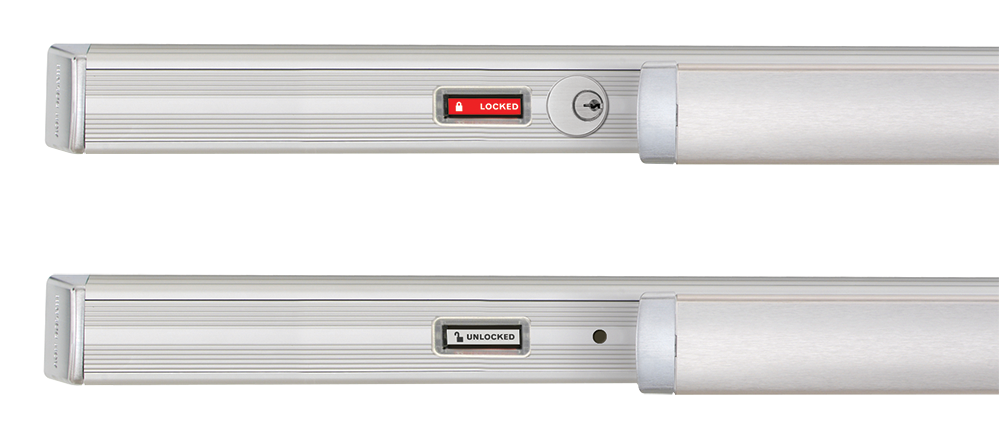In his latest post, Mark Kuhn explores lock status indicators…where are they required by code, and when are they just a good idea?
~~~
Status indicators are the big new thing in hardware, and like most pieces of door hardware there are places where they should be used and places where you are required to use them. I thought I could take this opportunity to go over some of those categories.
FIRST – Places where indicators are REQUIRED:
As far as I know, there are 3 places in the 2021 edition of the International Building Code (IBC) where the code specifically requires a lock to have an indicator. All 3 are also found in the 2024 IBC:
1) A family or assisted-use toilet: This is typically a privacy function lock with a built-in occupancy indicator on the outside of the door showing others that the restroom is in use. From the IBC, Chapter 11:
Doors to family or assisted-use toilet and bathing rooms shall be securable from within the room and be provided with an “occupied” indicator.
2) Main entry doors with key-operated locks. This is typically a double cylinder deadbolt with a built-in lock indicator which shows the status of the lock. The indicator ensures that building occupants can see whether the door is locked or unlocked without trying to open the door. The requirements for these doors are found in the Locks and Latches section of Chapter 10:
In buildings in occupancy Group A having an occupant load of 300 or less, Groups B, F, M and S, and in places of religious worship, the main door or doors are permitted to be equipped with key-operated locking devices from the egress side provided:
The locking device is readily distinguishable as locked.
(Refer to the code for additional requirements, including signage.)
3) Egress doors serving exterior spaces. A new section in the 2021 IBC addresses egress doors for exterior areas such as courtyards and roof terraces, where the means of egress passes through the interior of the building. Similar to the main entrance doors referenced above, these doors would typically utilize double cylinder deadbolts with built-in lock indicators, and the requirements are also found in the Locks and Latches section of Chapter 10:
Other than egress courts, where occupants must egress from an exterior space through the building for means of egress, exit access doors shall be permitted to be equipped with an approved locking device where installed and operated in accordance with all of the following:
The egress door locking device is readily distinguishable as locked and shall be a key- operated locking device.
(Refer to the code for additional requirements, including a weatherproof telephone, a clear window, and signage.)
SECOND – Places where indicators are a good idea:
Locations where you want to know at a glance that a door is secure or where you want someone else to know at a glance that the room is occupied could be good candidates for indicators. Let’s talk about those places:
1) Schools: Indicators on classroom doors help teachers, staff, and students to know when the classroom door is secure, but indicators can also be helpful on doors serving any room where someone might “shelter-in-place” during an active-shooter event. When this type of event happens, you don’t want to worry if the door you are hiding behind is locked. You want to KNOW IT’S LOCKED! Not only do you want to know it’s locked, but you also want to be able to lock it and see that it’s locked from inside the room.
Classroom security function locks were one of the first uses of indicators, but like I said, indicators are not only for classrooms. Large assembly spaces in schools, such as gymnasiums, cafeterias, auditoriums, libraries, etc., typically require panic hardware. Indicators showing the status of the lock or dogging feature on the panic hardware are recommended for doors in schools, although they are not currently required by code.
2) Rooms where privacy is important: I know that is super vague right? So let me help define it. Because IBC 2021-1110.2.1.6 addressed only family and assisted-use toilets, not all single occupancy public bathrooms are required by the code to have indicators. That is, unless I’m writing the spec…then ALL doors serving single toilets are specified with indicator locks. I think it’s only right – we all hate “The Knock!” I also specify occupied indicators for lactation rooms and even telephone rooms – anywhere you want or need privacy.
Where do you specify or supply lock status indicators?
You need to login or register to bookmark/favorite this content.














Ok
Always something new
The indicator. Took me a little to figure out what it Indicates!!!
So for others,,, is it a matter of training or use to learn what condition the door is in?
Maybe latched / unlatched,,, not sure if that would be any better
Anyway great article
https://www.vonduprin.com/content/dam/allegion-us-2/web-files/von-duprin-/information-documents/VON_Indicators_Infographic_115908.pdf
Thanks Charles.
-Mark
For my first time, we included indicators at classrooms (classroom intruder locksets). The school does not like them because they are only giving the status of the deadbolt. If the latchbolt is in the locked position and the deadbolt is not in the locked position, the indicator is saying “UNLOCKED” but folks without a key cannot enter the room.
Does anyone else find this confusing and causes an issue?
Robin,
I’ve never ran into this problem. I typically Spec the Schlage L9071 which doesn’t have a deadbolt. But, obviously different manufactures have different ways of handling this.
-Mark
Maybe it’s not the correct function for the application, at least when an indicator is involved.
With the proper function engaging the deadbolt will lock the outside lever, but the door doesn’t lock unless the deadbolt is thrown.
Yes, I agree.
-Mark
Always on single occupancy bathrooms.
I couldn’t agree more!
-Mark
I recommended that a client of mine, a large church, install indicator cylindrical locks for all classrooms and gathering spaces. Obviously, the logic was being able to tell the status of the door with a quick glance as opposed to a button. I reasoned to the client that it was particularly important to this application because there are no static assignments of teachers or even students (attendees). As a result, almost everyone would be unfamiliar with how to tell from across the room, if the lock is indeed secured. Knowing this, it would imply some training should be required for everyone who uses the building. A training mandate is very difficult to enforce or prove and over the years, it is unlikely to last.
They considered my recommendation but determined the cost was too significant. I later found that the indicators are only available on your Grade 1 locksets, Including the indicator, the price tripled.
I wonder if there are plans afoot to change this.
We specify the “Occupancy” Indicator on single occupant “Therapy Tub Rooms” at nursing homes and senior living, we had some instances that the owner also requested a light indicator tied into the light switch as another way to alert a care-giver that the room is being used.
Also, Schlage has electric locks that when the lever is thrown the “occupied” label turns on and the fob is disabled from outside, but always free to egress from inside. (There are override fobs in case of emergency).